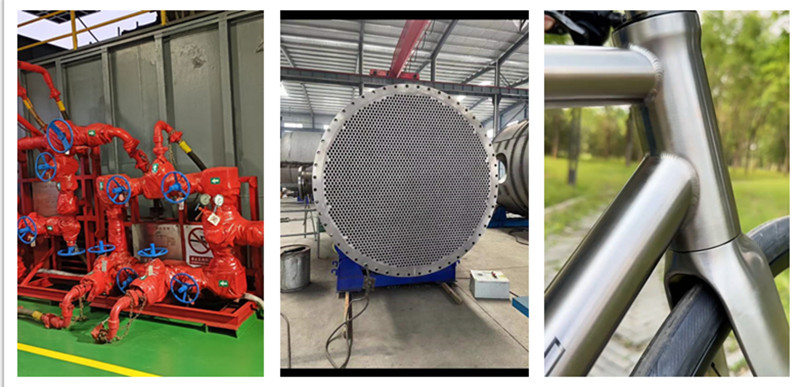How are titanium tubes made?
Processing Methods of Titanium Tubes: Seamless vs. Welded
Titanium tubes can be manufactured using two main processing methods: extrusion and welding. The choice of method depends on the performance requirements for different applications. Seamless titanium tubes are typically produced through extrusion. This method results in uniform strength, excellent corrosion resistance, high pressure tolerance, and no weld seams. These features make seamless tubes ideal for aerospace and deep-sea equipment.
Welded titanium tubes, on the other hand, are easier to manufacture. However, the welded seam can be a weak point, so they are generally used in applications with lower pressure requirements, such as chemical equipment, low-pressure pipelines, and structural supports.
Manufacturing Process of Seamless Titanium Tubes:
Heat titanium alloy bar stock to soften it
Feed it into a piercing machine to form a hollow tube shell
Hot-rolling the tube several times to bring its size closer to the target
Cold rolling or drawing to improve precision and surface quality
The result is a high-strength, high-sealing-performance seamless titanium tube
Manufacturing Process of Welded Titanium Tubes:
Cut titanium sheets or strips into appropriate sizes
Roll them into tube shapes with tightly joined edges
Weld the seam using specialized equipment
Grind the weld area and perform surface finishing
A welded titanium tube is formed
What are titanium tubes used for?
1. Seamless Ti Tubes in Aerospace Engine Cooling Systems
During operation, spacecraft engines generate extremely high temperatures. A cooling system is required to maintain normal performance. Seamless titanium tubes are used as coolant circulation channels due to their superior heat resistance and pressure tolerance. Without weld seams, they offer excellent sealing, and can endure strong vibrations and extreme environments.
2. Seamless Titanium Tubings in Deep-Sea Oil & Gas Equipment
Deep-sea environments demand materials that can withstand high pressure and seawater corrosion. Seamless titanium tubes, known for their lightweight, high strength, and corrosion resistance, are ideal for hydraulic systems and transport lines in offshore drilling platforms. They help ensure equipment operates safely and stably under harsh conditions.
3. Seamless Titanium Tubes in Nuclear Power Plant Cooling Systems
Cooling systems in nuclear power plants must operate reliably for extended periods. These systems often handle radioactive or corrosive media. Seamless titanium tubes are highly corrosion-resistant and pressure-resistant, making them ideal for main coolant pipelines and steam generators. Their no-weld design prevents leakage risks and ensures nuclear safety.
4. Seamless Titanium Tubes in Medical Implants
In surgeries—such as orthopedic implants, catheters, and stents—materials must be biocompatible and highly pure. Small-diameter seamless titanium tubes, precisely cold-worked for accuracy and smooth surfaces, are ideal for artificial joints or vascular stents. Titanium is non-toxic, non-magnetic, and does not cause rejection reactions, making it suitable for advanced medical devices.
5. Welded Titanium Tubes in Chemical Equipment Heat Exchangers
In chemical production, corrosion-resistant heat exchangers are needed to transfer heat efficiently. Welded titanium tubes, being more cost-effective and available in longer lengths, are commonly used in titanium heat exchangers. They resist acids and alkalis well, extend equipment service life, and meet low-pressure operation requirements.
6. Welded Titanium Tubes in Environmental Water Treatment Systems
Many wastewater treatment systems use pipelines to handle corrosive liquids. Welded titanium tubes offer excellent corrosion resistance and can be fabricated into large-diameter or custom shapes as needed—for filtration, reaction, or transfer sections. They are an economical and practical choice in environmental protection equipment.
7. Welded Titanium Tubes in Marine Freshwater Supply Systems
On ships and offshore platforms, freshwater systems are often exposed to seawater, which is highly corrosive. Welded titanium tubes, being more affordable, are ideal for low-pressure piping on vessels. They resist seawater corrosion, provide long service life, and maintain reliability while controlling costs.
8. Welded Titanium Tubes in Sports Equipment
Titanium tubing is increasingly popular in high-end sports gear like bicycles, trekking poles, and titanium kettles. Thanks to its lightweight, strength, and fatigue resistance, welded titanium tubing can be custom-shaped and sized, making it suitable for mass production of durable sports equipment.
9.Welded Titanium Tubes in Motorcycle and Racing Exhaust Systems
Titanium tubing is widely used in the motorsport and high-performance motorcycle industries—particularly in custom exhaust systems. Compared to stainless steel, titanium offers a superior strength-to-weight ratio, excellent heat resistance, and a unique aesthetic with heat discoloration.
Welded titanium tubes are often used to fabricate exhaust headers and muffler sections. These systems benefit from the tube's corrosion resistance and low thermal expansion, which reduces fatigue under vibration and high temperatures.
Thanks to the formability of welded titanium piping, custom builders can achieve complex bends and designs. When welded properly using TIG welding with full argon shielding, these tubes deliver long-lasting performance without cracking or oxidizing. This makes them a premium choice in the racing world, where every gram matters and reliability is key.
How to weld titanium pipes for exhaust?
Material Preparation
Ensure the titanium pipe edges are clean, oil-free, and oxide-free. Use stainless steel brushes dedicated only to titanium to prevent contamination.Shielding Gas
Use 100% argon with high purity (at least 99.999%). Both the weld pool and the backside of the pipe must be shielded to avoid embrittlement. A trailing shield or a purge box is often used.TIG Welding Process
TIG (GTAW) is the preferred method for titanium. Use a direct current electrode negative (DCEN) setup, and match filler wire with base metal (e.g., Grade 2, Grade 5).Heat Control
Avoid overheating. Titanium turns blue or purple when overheated, indicating contamination. A clean silver weld is a sign of proper shielding.Post-Weld Inspection
Inspect for discoloration and porosity. High-end applications (like racing) may require X-ray or ultrasonic testing to ensure weld quality.
Attention: Never do titanium weld in open air without proper shielding—once contaminated, it cannot be recovered by grinding or polishing.
